
When sending out automated emails to your list, how personalized are they?
I’m not talking about things like $firstname, or order by $date for free shipping – but actual personalization based on their behavioral triggers.
Let’s dig a little bit into the numbers behind this. According to the latest Blueshift Report, trigger-based marketing emails outperform batch and blast emails by 497%. Along with that, automated emails delivered 29% of all email marketing purchases with fewer than 2% of email sends.
Recently, behavioral email marketing showed high promise of sales. Think of this as something that’s bringing the above benefits together, helping companies increase ecommerce sales by simply using behavioral triggers via email, sometimes with automation. Built off the concept of behavioral marketing, this method helps get a pulse of your audience so you can interact with them in a way that makes sense.
Let those numbers sink in a minute.
The potential for making the most of behavioral email marketing is wide open, and yet, according to Econsultancy, only 20% of marketers are using behavioral targeting.
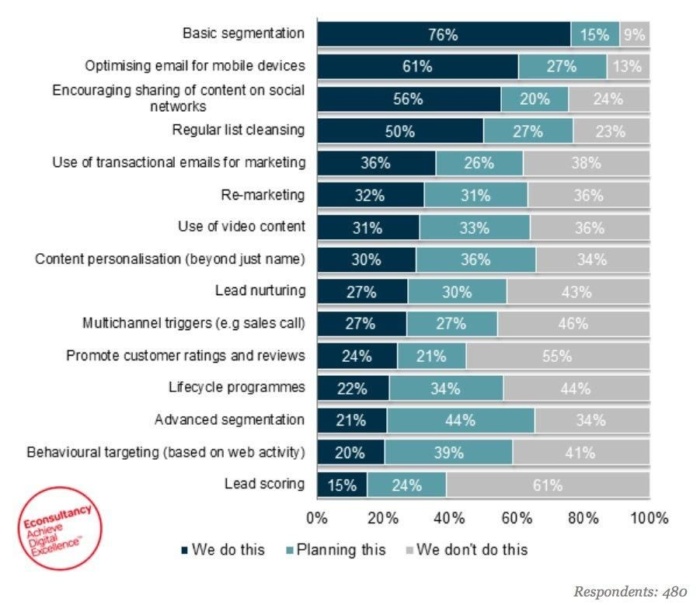
Why is that? Let’s take a closer look at the core issues and learn how to get started with behavioral email marketing.
Send Emails Based On Customer Actions
Now, not all of these points will be email “action-worthy,” so it’s up to you to figure out what actions the user takes (or doesn’t take) that are worth sending an email. You may have even seen this kind of behavioral targeting email marketing at work when you sign up for a service, but don’t complete your profile or verify your email address. If the company is smart, they’ll send you an automated email reminding you to do so.
But re-targeting the user in this way isn’t the only way to leverage behavioral targeted emails. You can also send out targeted messages, for example, when a customer:
- Submits a form to download your white paper, video, case study or other free item.
- Views certain content on your web page. If they spent some time browsing the FAQ, you can set up a behaviorally targeted email to check in and see if they have any specific questions.
- Leaves an item in their cart without checking out. You could send them a reminder email with a small discount, remind them of limited stock (or that their cart will expire) and so on.
Remember, with behavioral email marketing, it’s the customer at the wheel — not you. They’re making choices while interacting with your content. Behavioral marketing is designed to act on those choices with the kind of engagement that increases conversion rates, grows profits, and vastly improves customer retention.
Discovering Behavioral Email Marketing Trigger Opportunities
Once you start collecting and analyzing the information that you gather on your customers, new opportunities for behaviorally targeted emails will percolate to the surface. You’ll start getting all kinds of great ideas on how to guide users back into your service. To help get you started, here’s an overview of email marketing formats I consider some of my favorites:
The “Getting Started” Email
Also known as an “onboarding” email, this message is usually sent after you create an account or register for a service. It’s designed to get you clicking and interacting with the service as quickly and fluidly as possible. Here’s an awesome example from Stocksy, a stock photography site:
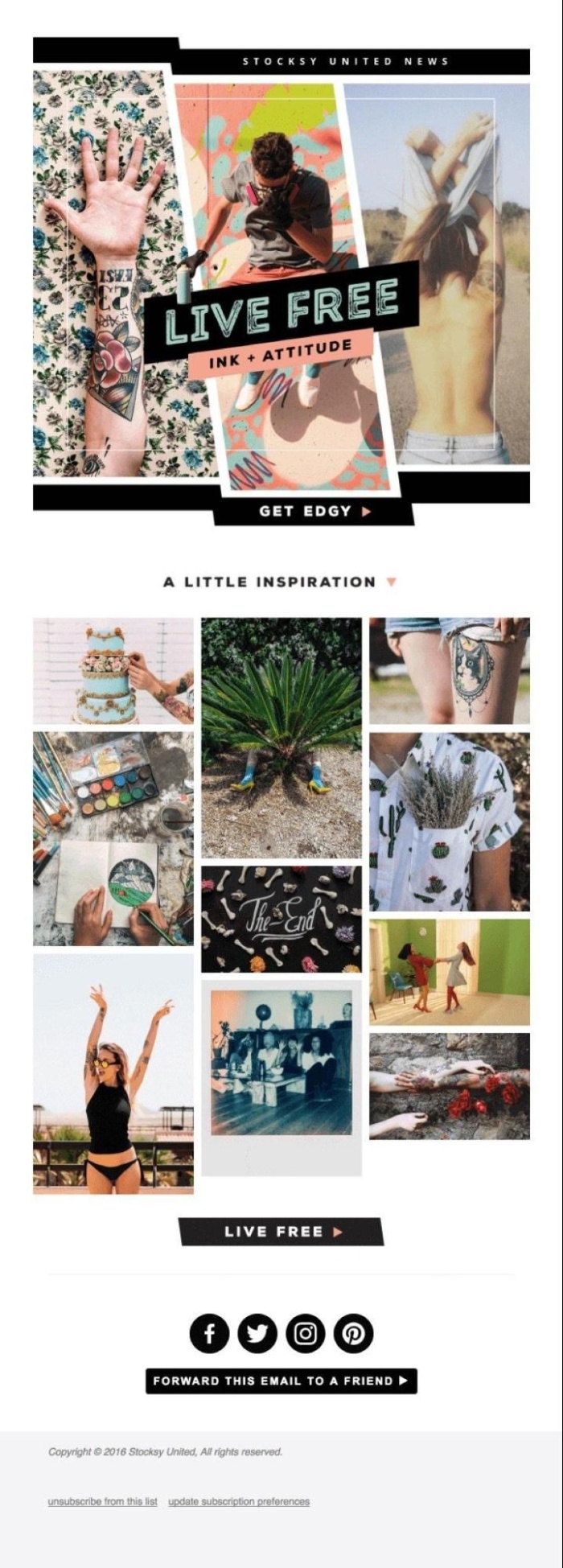
Notice how they’ve carefully curated images in emails on a specific theme – then encourage you to click through and check them out for more design inspiration. Here’s another example from Airbnb:

If you’ve been browsing trips to wine country, this targeted email can help make your tour much more palatable through the offer of discounts, local guides, special attractions, and more.
The Notification Email
The notification email is generally just a canned response from your account or user management software that tells people their username and password, and maybe has a link to some documentation to get started. That’s where most of the getting started automating of the process ends — which results in a lot of confused or frustrated users.
Instead, encourage them to take the first step toward trying out your product by offering more of a guided, hands-on tour. If you have a SaaS, walk them through using it by helping them to create their very first _____ — such as a website, playlist, or campaign. This sort of guided, pop-up tour will help them feel more at ease, and can also give you even more valuable data for your behavioral targeting email marketing goals.
The Icing on the Cake Email
These are the unexpected but highly welcomed emails that encourage better customer retention. Here’s a great example from Shopify that lets users extend their free trial of the service:
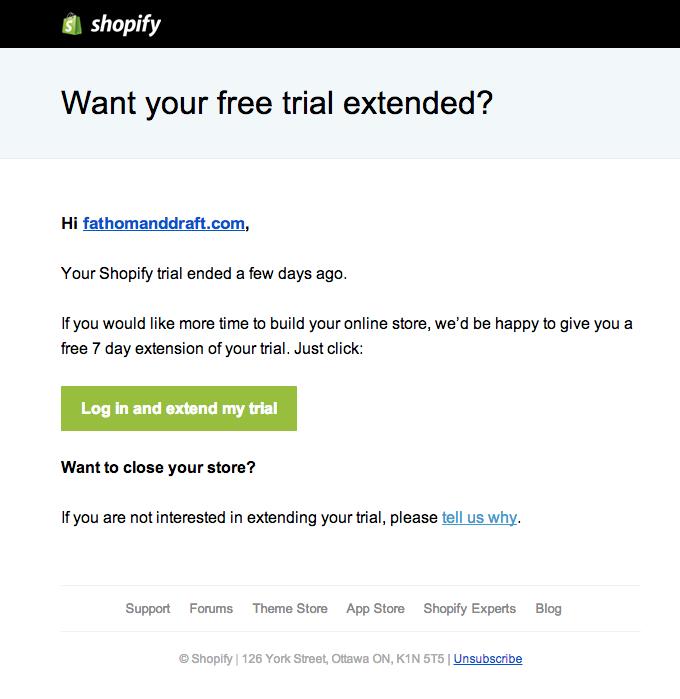
Another example comes from TurboTax, which is designed to pique the user’s curiosity about how much their tax refund could be, before they ever see a check in the mail:

It also promotes the benefits of using the TurboTax service, but without being overly “sales-y” or pushy. Rather, it shifts the focus onto the customer and their end goals – which revolve around getting the biggest refund possible at tax time.
The Reward Email
Everyone loves getting an unexpected reward — even if it’s a digital “good job!” Here’s an example of an email from Withings, which is a Fitbit-style product that helps inspire healthy habits by tracking your activity. Here, you can see a user has won a badge for taking 8,000 steps in a day, and unlocked the Marathon reward. They can also share their progress on Twitter or Facebook.
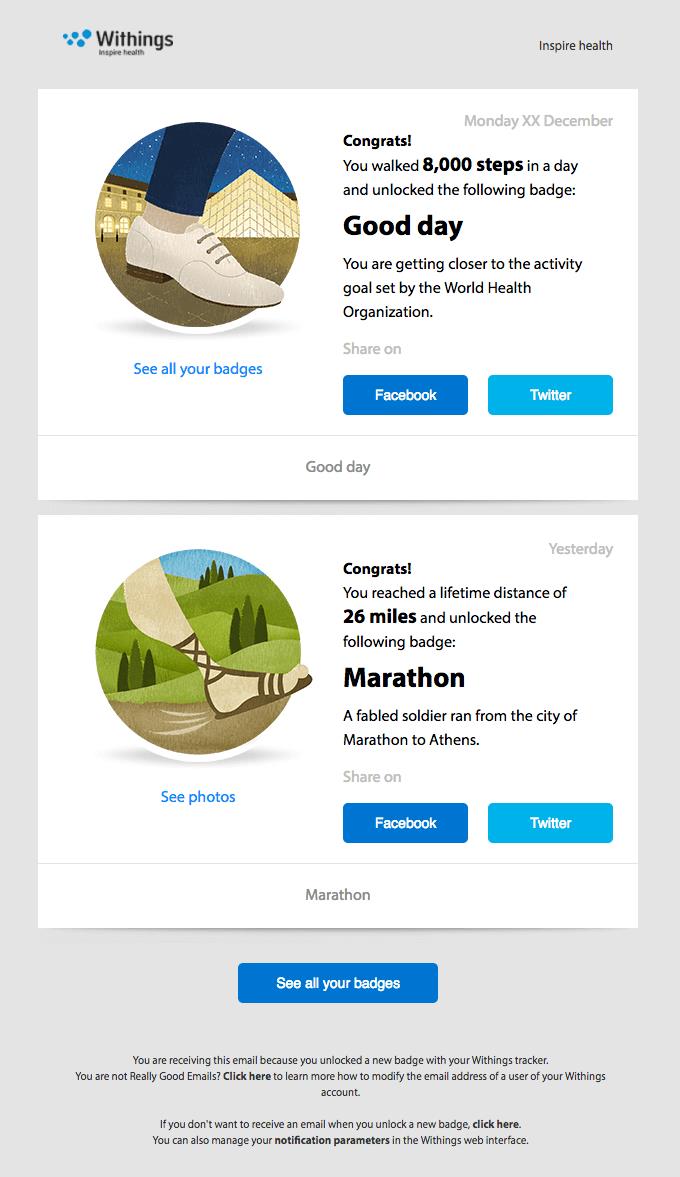
The Recommendation Email
Oftentimes, great customer service from a company is enough to get you to recommend them. But what if the brand sweetened the deal? Bombas, which sells socks online, provides free socks, with no limit, to people who tell their friends about them. Those friends get a discount on socks, and the referrer gets more socks. And we all know you can never have enough socks.
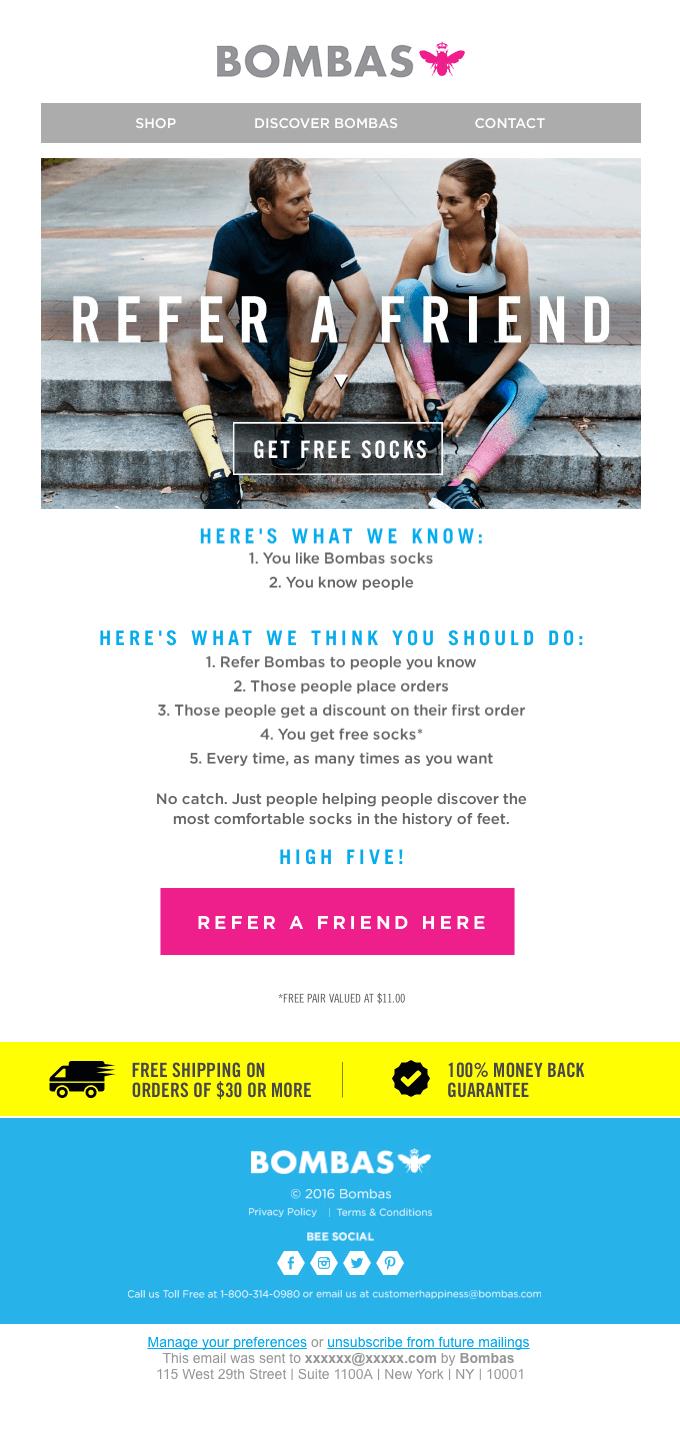
Transactional Emails
Did you know that transactional emails (receipts, shipping notifications, etc.) are opened up at 8x the rate of regular emails? With this in mind, it’s worth going through the ones your company sends and doing away with those dusty old “order confirmed” messages, to make every note you send one that not only thanks the customer for their order, but does so in a way that’s more akin to having a conversation than making a statement.
This Slack notification for the user to get involved with the app on mobile does just that by having a link to their blog in the footer:
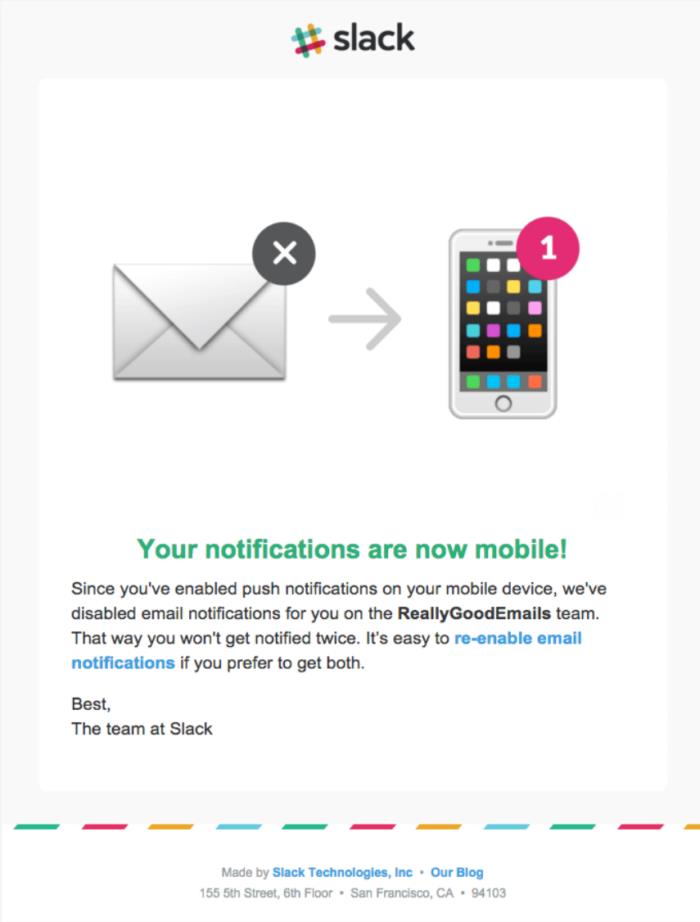
It’s not invasive, but the user knows the brand has more in store. Those are the kinds of placements in your trigger emails that will keep leads engaged.
Frequently Asked Questions
What is behavioral email marketing?
Behavioral marketing refers to the response to each lead’s behavior with the kind of engagement that boosts conversion rates, revenues, and customer retention.
How can I create emails based on user behavior?
Think of this email in the formula of an “if-then” clause. For example, if a customer abandoned their cart, email them to remind them of the quality products they’re leaving behind. Try including a coupon, because that prompts leads to convert as well.
What is behavioral targeting in email marketing?
Behavioral targeting in the email marketing world is sending out specific emails to consumers based on their past behavior. For example, sending a different email to someone who brought a product from your online store versus someone who filled their cart, but never checked out.
What are the 4 types of marketing emails?
The 4 main types of marketing emails are as follows:
- Email newsletters, sharing company news and relevant product updates.
- Acquisition emails, designed to introduce customers to your sales funnel for products or services.
- Retention emails, designed to keep customers engaged in your sales funnel.
- Promotional emails, which highlight deals or other specific opportunities to purchase/engage with your brand.
What makes an email unprofessional?
Aside from standard issues like typos, broken images, or formatting issues, some things that may flag an email as unprofessional include:
- A bad template that is difficult to read.
- Using bait-and-switch headlines to trick people into reading.
- Having an overly long email before getting to your CTA.
- Sending too many emails in a short period of time. This may get your content marked as spam.
What are the 3 most important things for an email?
While the answer may vary here based on market and customer base, 3 things that are universal are:
- Adding a personalization element to the emails whenever possible.
- Be sure to sound human, not like a sales robot.
- Having some form of CTA or CTAs to move the reader into the sales funnel.
Should I target every consumer with behavioral email marketing?
You’ll want to create a few samples to send that depend on the scenario and behavior of the lead. Having an email tailored towards a user’s experience will feel more genuine, guiding them to convert.
Conclusion
The bottom line is getting more behavioral triggers in your marketing strategy is going to make it better. Trigger-based campaigns offer the appropriate material and messaging to the subscriber at the right time, matching where they are in the funnel.
At the core, trigger email marketing operates by nurturing subscribers depending on their interaction with your brand.
You can keep your lead’s attention by sending timely, relevant emails.
This can show more prospect engagement, more clickthroughs, increased customer purchases, retention, and an overall positive experience.
Marketers who aren’t getting on the behavioral email marketing train are missing out, so get started by following the best practices I recommend.
Get creative with your triggers and see how your tactics convert more leads.
Which behavioral triggers have you found to be the most effective in your marketing campaigns? Let me know in the comments!
About the Author: Sherice Jacob helps business owners improve website design and increase conversion rates through compelling copywriting, user-friendly design and smart analytics analysis. Learn more at iElectrify.com and download your free web copy tune-up and conversion checklist today!
Frequently Asked Questions
What are the benefits to being entrepreneurial?
There are many benefits to being an entrepreneur. First, you are more self-reliant. You stop relying on other people.
You will be able to work for yourself and follow your dreams. It helps you make connections with other entrepreneurs who share similar interests and challenges.
You gain confidence. Entrepreneurs learn constantly. This gives you the ability adapt quickly and to be flexible. You won't be stuck in a rut if you think outside the box.
All entrepreneurs are free to start their own businesses. We no longer have to follow the rules and regulations set out by society. We can choose what we want and how we want it to go.
We can choose either to follow the crowds or go against them. You can choose to succeed or fail. We can choose to fail or win.
It is exhilarating. It comes with a fair amount of responsibility. Because once you step into this role, you're accountable for everything that happens within your business.
Learning to manage risk is key to success. You shouldn't be afraid of trying new things. If you are willing and able to learn from your failures, you will eventually reach your goals.
These lessons will help you to stay on the right track when you embark on your journey.
Remember:
- Entrepreneurship can be a way to live your life.
- You are the boss when you own your business.
- Avoid following the latest trends.
- Success doesn't come in money; it comes in freedom.
- Balance your personal and professional life.
- Set clear expectations.
- Always be truthful with your team.
- Do something about it if you want things to happen.
What are the 3 motivators of an entrepreneur
Entrepreneurs have three primary motivations: freedom, money, knowledge.
- Freedom means being able to do what you like whenever you like. When our lives or jobs are restricting us, we can become entrepreneurs.
- Money is also very important because we would not even consider starting a business without it. Money is essential for survival.
- The third motivator is knowledge. Entrepreneurship is a constant learning process. We often read books, attend seminars and take online courses to learn how to make products and services.
This is what motivates and drives us to reach our goals. It gives us purpose, meaning.
These three factors are what made us entrepreneurs. They are our main driving force that keeps us going day in and day out.
These three things might be the reason we pack up and leave. We won't be truly happy if we don't have the three things we need.
What is the importance of motivation for entrepreneurs?
When we feel lost or stuck in life, motivation is the fuel that propels us forward. It helps us face our fears and make difficult decisions.
Motivation is key to success. When we lack motivation, we become lazy, unmotivated, unproductive, and ultimately unsuccessful.
You can unlock your potential by finding ways to motivate you. This means that you need to find ways to keep motivated throughout the day.
Think of it like a muscle - the more you exercise it, the stronger it becomes. It will weaken and atrophy if you don't exercise.
Self-motivated entrepreneurs are the best. They set goals, plan their progress, and then follow through.
However, there will be times when motivation is needed. Here are three simple steps to help you keep going.
Step 1) Get inspired. Find an example of someone who inspires. Someone who has already achieved what you want.
Step 2. Establish small goals. Step 2) Set small goals. Focus on the next step rather than the ultimate result. You'll be able reach your goals faster if you break down large goals into smaller ones.
Step 3: Reward yourself. Give yourself rewards when you've completed your goals. You don't need a reward to be material. It could be as simple as taking the time to do something that you enjoy.
Remember that motivation is a choice. Choose happiness, choose success, and live a full life.
You can make a difference in your life today. It is important to take the first step and decide to change. Next, take action. Now is the time to live your dreams.
What motivates entrepreneurs?
Passion is what drives us. However, our passion drives us to do meaningful work that makes a positive difference. To make a positive difference in the lives of our loved ones and ourselves.
To give back. To give back. To leave behind a legacy.
We love it. Because we feel compelled by God to live our lives fully and succeed in things that matter.
We are driven to fulfill a sense purpose and mission. This cannot be accomplished by money alone.
The key here is to find a way to combine business with pleasure. This is when entrepreneurship is more than a job.
This is why I love helping entrepreneurs succeed. My goal in helping entrepreneurs achieve financial freedom and make a lasting difference in the world is my goal.
My life is proof that creating value is the best thing. Sharing your knowledge and expertise with others.
It is not enough to create a great product. To understand your customers and what their needs are, you need to first get to know them. What they are looking for.
If you do, you'll always know how to improve your offering. You will always be able to provide more value.
Customers will be more satisfied if you offer more value. And if you gain more customers, you will sell more products and services. And if you sell more products and services, you will generate more revenue. You will eventually be financially independent if you have more revenue.
Money is not everything. It's the means to an end. It's not the end itself.
It is not enough to focus on money if your goal is to live a full and happy life. Make a positive impact. Contributing. Leave a legacy. It is creating something of value. You create something unique. A unique thing that gives meaning to your and others lives.
Entrepreneurship requires risk-taking. However, it does not mean following any set of rules. Flexible means being open to change. Adapting. Adjusting. Improving.
You will succeed as long you are true and honest with yourself.
Entrepreneurship should be considered a calling. A vocation. The chance to give back. To build wealth. To create history.
These are the things that will make you the best version you can be.
You will not be stopped.
What are 6 essential questions that entrepreneurs must ask to be motivated?
For any business, motivation is key. You won't get out of bed each morning if you don't have motivation. You won't be able to complete projects if you don't have motivation. You can't reach your goals without motivation. How do you find your motivation?
Perhaps you are asking yourself "What motivates?" It might surprise you to find out the answer. You might have been asking the same question for many years. You're missing one of the greatest rewards in life, the chance to find your motivation.
It's the most motivating thing to discover why you are here. That's when you finally begin to realize what drives you. Your purpose becomes clearer and more meaningful. What is your purpose? Once you know why you care, it will make it easier to stay motivated.
The key to finding your motivation is to look within. These are some questions to ask yourself:
- What am I passionate about?
- What makes your heart beat faster?
- What's the thing that makes me happy?
- What gives you butterflies in your stomach?
- What makes me feel alive and connected?
- What makes you come back to your project again and again?
Once you have the answers, you can identify your true motivations.
Motivation will be your strength through difficult times. It will give strength when you need. It will make you work harder. You will be motivated to achieve your goals.
If you're anything like me, you will never stop searching for your motivation.
Spend some time today reflecting on your motivations. You might be surprised at your discoveries.
How to Motivate yourself as an Entrepreneur
The best way to motivate yourself is to find someone else who is motivated to do what you are trying to do. Ask someone who's working hard to reach his goals for how he achieved them.
Ask for advice, listen, learn and most importantly follow it. Follow the example of someone who is successful.
Do what it takes to be that person. Learn from them. Take their lead. Follow their example.
Keep moving forward. Keep moving. Never stop learning. Never give up.
Never allow anyone to tell you that your abilities aren't possible. Don't listen to anyone who tells you there is no path.
You might fail but that doesn’t mean you’re a failure. Failure can be an opportunity to learn and grow. To find out more. To push harder.
Failure is just one step on the path to success.
Let's get started! Get started today and you will be closer to your goals.
Why wait?
Statistics
- According to analysts, Johnson has high appeal in all four quadrants tracked at the multiplex: male, female, over-25 and under-25. (forbes.com)
- “Life is 10% what happens to you and 90% how you react to it.” (oberlo.com)
- Invest at least 30% managing those with authority over you and 15% managing your peers.” (americanexpress.com)
- Our 10 years of research also shows that 75% of mentored entrepreneurs increased their revenue, and 82% of their businesses survived the first two years. (carolroth.com)
- "Most of the time when people ask me about motivation, 80 percent of the time, I attribute it to gratitude. (entrepreneur.com)
External Links
oberlo.com
inc.com
businessinsider.com
- 101 Best Inspirational Quotes For Entrepreneurs
- Why Elon Musk sets nearly impossible goals for SpaceX employees
twitter.com
How To
How can I keep my motivation high when starting a new business?
You must focus on creating an income stream if you want to make online money. This means developing a way to generate consistent revenue from your website.
You can do this by creating products that solve customers' problems. How can you create these products, though? That's where the real fun begins.
There are two approaches to product creation. One is to come up with a great idea and then spend hours perfecting it, which is probably the most traditional method.
However, there is another option. It's possible to simply ask, "What problem are I trying solve?" and then proceed to find a product that solves that problem.
This is known as the "find-a problem" method. You're likely to find a problem on another site if you use the "find-a-problem" method.
Once you have determined the problem, then you must decide if it is worth solving. These are the three most important questions to ask:
- Is it worthwhile?
- It is possible.
- Will it make a difference?
If you can answer the three questions correctly, you have the basis for a great product. The next step is to determine how to package it.
A lack of a strategy for generating recurring revenues is the reason that most businesses fail. Once you create your plan, you will find it easier to carry on even when you run out of ideas.
Sometimes you may find yourself with more ideas than time to put them all into practice. This is where you can either delegate tasks to your team members or hire freelancers.
You will remain motivated so long as you keep growing your income stream.
Don't forget to be patient and work hard. You can accomplish anything if your willing to do so. Don't wait! So why wait? Get going today!






